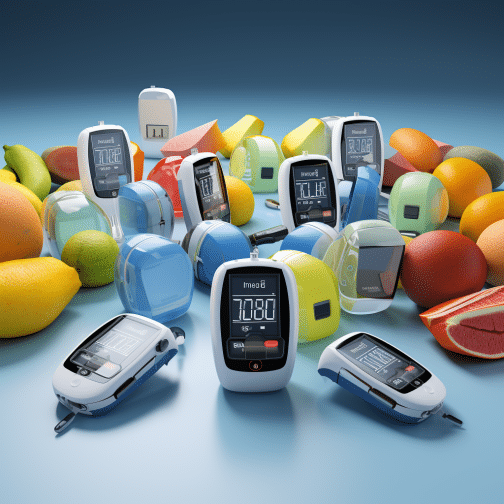Digital Insulin Dosing: Using Algorithms to Determine Insulin Requirements
 Digital Insulin Dosing
Digital Insulin Dosing
Introduction
Diabetes management has seen remarkable advancements over the years, thanks to innovative technologies and medical breakthroughs. One such advancement is the integration of digital insulin dosing, which leverages algorithms and digital insulin pumps to deliver precise insulin doses tailored to individual needs. In this extensive guide, we will explore the world of digital insulin dosing, how it works, its benefits, and its impact on diabetes management. Whether you’re a healthcare professional, a person with diabetes, or someone interested in the latest advancements in diabetes care, this guide will provide valuable insights into this cutting-edge approach.
The Evolution of Insulin Therapy
Insulin therapy has long been a cornerstone of diabetes management, especially for individuals with Type 1 diabetes or those with advanced Type 2 diabetes. Traditional insulin therapy relied on fixed dosages and schedules, often requiring individuals to adhere to strict routines. However, the introduction of digital dosing has transformed the landscape of insulin therapy.
Components of Digital Insulin Dosing
Digital insulin dosing combines hardware and software components to provide precision in insulin delivery:
- Digital Insulin Pump: The core of this technology is the digital insulin pump, a device that delivers insulin in precise doses. These pumps are programmable and can be adjusted to match an individual’s insulin requirements.
- Continuous Glucose Monitoring (CGM) System: To determine the appropriate insulin dose, a CGM system is used to monitor blood sugar levels continuously. The data from the CGM is crucial for making real-time insulin dose adjustments.
- Insulin Dosing Algorithm: A sophisticated algorithm processes the data from the CGM system and calculates the optimal insulin dose needed to maintain blood sugar within the target range.

How Digital Insulin Dosing Works
Digital insulin dosing is a dynamic process that adapts to an individual’s changing insulin needs. Here’s a step-by-step breakdown of how it works:
1. Continuous Glucose Monitoring
A small sensor placed under the skin continuously measures blood sugar levels. The data is transmitted to a receiver or smartphone app, providing real-time glucose readings.
2. Algorithm Analysis
The algorithm processes the glucose data and considers factors like meal consumption, physical activity, and the individual’s insulin sensitivity. Using this information, it calculates the insulin dose required to maintain stable blood sugar levels.
3. Insulin Delivery
The digital insulin pump administers the calculated insulin dose in a precise manner. Some pumps offer both basal (background) insulin and bolus (mealtime) insulin, ensuring comprehensive blood sugar control.

4. Continuous Monitoring and Adjustment
The CGM system continues to monitor blood sugar levels, providing ongoing feedback to the algorithm. If blood sugar begins to rise or fall out of the target range, the algorithm adjusts the insulin dose accordingly.
Benefits of Digital Insulin Dosing
Digital dosing offers numerous advantages for diabetes management, making it an appealing option for many individuals:
1. Precision and Accuracy
One of the key benefits is the precision in insulin dosing. By continuously monitoring blood sugar levels and adjusting insulin doses in real-time, insulin dosing minimizes the risk of hypo- and hyperglycemia.
2. Improved Quality of Life
The flexibility and automation of this approach can improve the quality of life for individuals with diabetes. It reduces the need for frequent manual insulin adjustments and allows for greater freedom in daily activities.
3. Customization
Digital insulin dosing can be customized to match an individual’s unique insulin requirements, making it suitable for people with varying sensitivities to insulin and changing routines.
4. Enhanced Data Insights
The CGM system provides a wealth of data that individuals and healthcare professionals can use to gain insights into blood sugar patterns and make informed treatment decisions.
5. Reduced Burden
This technology can alleviate some of the burdens associated with diabetes management, such as the need for frequent injections and the complexity of manual insulin adjustments.

Is Digital Insulin Dosing Right for You?
While digital dosing offers remarkable benefits, it’s important to assess whether it aligns with your unique needs and circumstances. Making an informed decision requires careful consideration of several factors:
1. Type of Diabetes
Digital insulin dosing is primarily employed in individuals with Type 1 diabetes or those with advanced Type 2 diabetes who require intensive insulin therapy. If you have a different form of diabetes or your diabetes is well-managed with other treatments, digital insulin dosing may not be the most suitable option.
2. Commitment to Continuous Monitoring
Successful digital insulin dosing relies on continuous glucose monitoring (CGM). You must be committed to wearing the CGM sensor and engaging with the technology regularly. This involves checking your CGM data, understanding the information it provides, and making informed decisions based on those readings. If you are not prepared for this level of monitoring or prefer a less technology-intensive approach, digital insulin dosing may not be the right fit.
3. Access to Technology
To benefit from digital insulin dosing, you need access to the necessary technology components, including a digital insulin pump and CGM system. Availability may vary by location and healthcare provider, so consider whether you can obtain these devices and if they are covered by your insurance.
4. Healthcare Provider Guidance
Digital insulin dosing should be initiated and monitored under the guidance of a healthcare provider experienced in this technology. Your healthcare provider will help you set up and calibrate the system, provide ongoing support, and adjust your treatment plan as needed. If you do not have access to a healthcare provider with expertise in digital insulin dosing or if you prefer a more traditional approach to diabetes management, this technology may not be the best choice.
5. Lifestyle and Personal Preferences
Consider your lifestyle and personal preferences when evaluating digital insulin dosing. Some individuals may prefer the convenience and flexibility it offers, while others may find it overwhelming or intrusive. Your willingness and ability to adapt to a more technology-driven approach should align with your comfort level and daily routine.
6. Financial Considerations
Digital insulin dosing involves the cost of insulin pumps, CGM systems, sensors, and ongoing supplies. Insurance coverage may vary, so it’s essential to assess the financial implications of this technology. Speak with your insurance provider to determine coverage details and potential out-of-pocket expenses.
7. Long-Term Commitment
Digital insulin dosing requires a long-term commitment to technology-based diabetes management. Consider whether you are ready to embrace this approach for the foreseeable future, as discontinuing or switching to a different treatment method may have implications for your diabetes management.
8. Individual Health Goals
Your health goals and expectations play a significant role in determining whether digital insulin dosing is right for you. Discuss your treatment objectives with your healthcare provider, whether it’s achieving tighter blood sugar control, reducing the risk of hypoglycemia, or simply improving your quality of life with diabetes.
Technical Reviews and Considerations
Here are some technical reviews and considerations about digital insulin pumps:
- Accuracy and Precision: Digital insulin pumps are designed to deliver precise insulin doses based on real-time data from continuous glucose monitoring (CGM) systems. Users have reported that these pumps offer excellent accuracy in insulin delivery, reducing the risk of both high and low blood sugar episodes.
- Customization: A notable advantage of digital insulin pumps is their high level of customization. Users can program basal rates, insulin-to-carb ratios, and correction factors to match their unique insulin requirements. This level of personalization allows for fine-tuning of insulin delivery throughout the day.
- Integration with CGM: The integration of digital insulin pumps with CGM systems provides users with a comprehensive view of their blood sugar trends. This real-time data empowers users to make informed decisions about insulin dosing, reducing the need for manual calculations.
- Automated Insulin Adjustment: Many digital insulin pumps feature automated insulin adjustment algorithms that can proactively increase or decrease basal insulin rates based on CGM data. Users have found this feature particularly useful for maintaining stable blood sugar levels during periods of physical activity or overnight.
- Ease of Use: These pumps often come with user-friendly interfaces and touchscreens, making them accessible and easy to navigate. Patients have reported that the intuitive design simplifies daily management tasks.
- Bolus Calculations: Digital insulin pumps typically calculate bolus insulin doses based on factors such as current blood sugar, target blood sugar, and meal carbohydrates. Users appreciate the convenience of automated bolus calculations, which reduce the need for manual math.
- Alarm Systems: Advanced alarm systems in digital insulin pumps provide timely alerts for high and low blood sugar levels. These alarms can be customized to suit individual preferences, enhancing user safety and awareness.
- Data Sharing: Some digital insulin pumps offer data-sharing capabilities, allowing users to share CGM data with caregivers or healthcare providers remotely. This feature fosters improved communication and support, especially for parents of children with diabetes.
- Software Updates: Manufacturers frequently release software updates for digital insulin pumps, enhancing their capabilities and addressing any reported issues. Users appreciate the ability to keep their devices up-to-date with the latest features and improvements.
- Compatibility: It’s essential to consider the compatibility of digital insulin pumps with other diabetes management tools and devices. Many pumps can communicate with smartphones and diabetes management apps, streamlining data analysis and sharing.
- Wearability and Comfort: The size, design, and wearability of digital insulin pumps vary among models. Users often prioritize pumps that are discreet, comfortable to wear, and easy to conceal under clothing.
- Battery Life: Battery life is a crucial consideration. Most digital insulin pumps are rechargeable and offer extended use between charges. Users appreciate pumps with long-lasting batteries to minimize interruptions in insulin delivery.
- Customer Support: Users value responsive customer support from manufacturers and distributors. Reliable support is essential for troubleshooting technical issues and ensuring the continued functionality of the pump.
- Cost and Insurance Coverage: Cost is a significant factor when choosing a digital insulin pump. Users often seek insurance coverage to offset the expenses associated with pump acquisition, supplies, and ongoing maintenance.
- User Feedback: Reading user reviews and seeking feedback from others who have experience with specific pump models can provide valuable insights into real-world experiences and satisfaction levels.
It’s essential to consult with healthcare providers, including endocrinologists and diabetes educators, when considering a digital insulin pump. They can help assess your specific needs, guide you through the selection process, and provide comprehensive training on pump usage for safe and effective diabetes management. Additionally, discussing insurance coverage options and financial considerations is essential to ensure affordability.
Future Trends in Digital Insulin Dosing
The field of digital insulin dosing continues to evolve, with ongoing research and development efforts. Some emerging trends include:
- Artificial Intelligence (AI): Integration of AI algorithms to enhance the precision of insulin dosing and automate decision-making processes.
- Closed-Loop Systems: Development of closed-loop systems, also known as “artificial pancreas” systems, which combine digital insulin dosing and automated insulin delivery.
- Interoperability: Efforts to improve the compatibility and interoperability of insulin pumps and CGM systems from different manufacturers.
- Mobile Apps: The development of user-friendly mobile apps that provide individuals with diabetes more control and insights into their treatment.
- Remote Monitoring: Expansion of remote monitoring capabilities, allowing healthcare providers to remotely access and analyze patient data.
Conclusion
Digital insulin dosing represents a significant advancement in diabetes management, offering precision, flexibility, and improved quality of life for individuals with diabetes. While it may not be suitable for everyone, it provides an exciting option for those seeking advanced tools to achieve optimal blood sugar control.
As technology continues to advance, the future holds promise for even more sophisticated and user-friendly digital insulin dosing systems. These innovations have the potential to further revolutionize diabetes care and empower individuals to lead healthier, more fulfilling lives with diabetes.
If you are interested in exploring digital insulin dosing as a diabetes management option, consult with your healthcare provider to determine if it aligns with your needs and preferences. By staying informed about the latest developments and treatment options, you can make proactive choices in managing your diabetes effectively.
Remember, diabetes management is a journey, and embracing the possibilities of digital insulin dosing is just one step toward achieving better blood sugar control and a brighter future with diabetes.


















